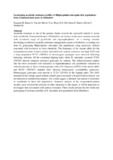Please use this identifier to cite or link to this item:
https://cris.library.msu.ac.zw//handle/11408/3225| Title: | Genotytyping acaricide resistance profiles of rhipicephalus microplus tick populatios from communal areas of Zimbabwe | Authors: | Sungirai, Marvelous Baron, S. Moyo, Doreen Zandile De Clercq, P. Maritz-Olivier, C. Madder, Maxime |
Keywords: | Acaricide resistance Genotyping Rhipicephalus microplus |
Issue Date: | 2018 | Publisher: | Elsevier | Series/Report no.: | Ticks and Tick-borne Diseases;Vol. 9, No. 1: p. 2-9 | Abstract: | Acaricide resistance is one of the greatest threats towards the successful control of vector ticks worldwide. Communal farmers of Zimbabwe use amitraz as the most common acaricide with occasional usage of pyrethroids and organophosphates. As a strategy towards developing an effective acaricide resistance management system in Zimbabwe, screening was done by genotyping Rhipicephalus microplus tick populations using molecular markers associated with resistance to these chemicals. The frequency of the mutant allele for the octopamine/tyramine receptor marker associated with amitraz resistance was high (0.55) and a large proportion 78.5% (288/367) of heterozygote genotypes were observed indicating balancing selection. Of the communal dipping tanks where R. microplus occurred 37.8% (39/103) showed complete resistance genotypes for amitraz. The carboxylesterase marker that has been associated with resistance to organophosphate and pyrethroids indicated no selection pressure in these chemical groups with a low frequency (0.052) of the mutant allele and 89.6% (329/367) sampled ticks showing homozygous susceptibility genotypes. Heterozygous genotypes were present at 27.2% (28/103) of the dipping tanks. The L641 mutation in the voltage–gated sodium channel gene associated with pyrethroid resistance was not detected in Zimbabwean samples. This would suggest a different mechanism of resistance to pyrethroids in these tick populations. Sequence analysis of the octopamine/tyramine receptor gene revealed the presence of other mutations in this region, it will be important to investigate their association with amitraz resistance. These results present the first molecular genotyping of resistance profiles of R. microplus tick populations from Zimbabwe. | URI: | https://doi.org/10.1016/j.ttbdis.2017.10.017 http://hdl.handle.net/11408/3225 |
ISSN: | 1877-959X |
| Appears in Collections: | Research Papers |
Files in This Item:
| File | Description | Size | Format | |
|---|---|---|---|---|
| Genotyping acaricide resistance profiles of Rhipicephalus microplus tick populations from communal land areas of Zimbabwe.pdf | Abstract | 108.67 kB | Adobe PDF |  View/Open |
Page view(s)
172
checked on Jan 20, 2026
Download(s)
26
checked on Jan 20, 2026
Google ScholarTM
Check
Items in MSUIR are protected by copyright, with all rights reserved, unless otherwise indicated.



